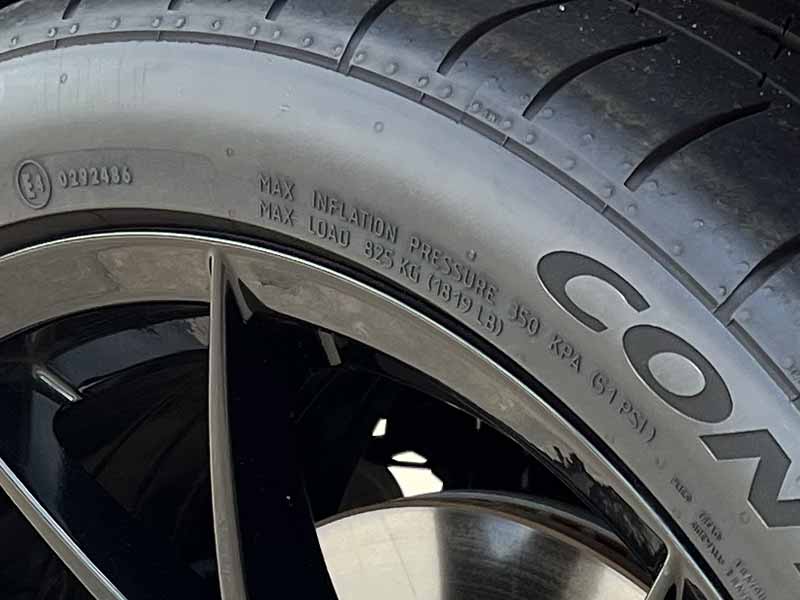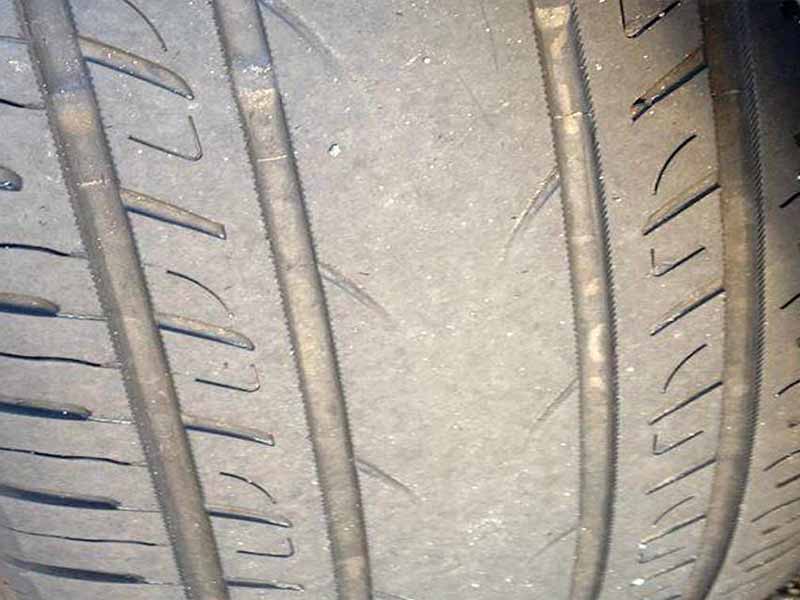Uneven tire tread wear is a common problem for many vehicle owners. Fortunately, tire wear along the middle of your tire tread is usually easily corrected.
Unfortunately, once the damage has been done it can’t be completely fixed, but it can be reduced and so that you can still get the most out of what’s left of your tire tread.
Center Tire Wear
Middle of tire wear is usually a result of overinflation.
Overinflated tires will budge along the center of the contact patch and cause the middle of the tread to wear faster than the inner or outer edge.
Overinflation isn’t the only factor to keep in mind. Making sure your tires meet the load index and are properly sized is also important if you’re struggling with maintaining even tire wear.
Unlike many other unwanted tire wear patterns, alignment issues aren’t a cause for this pattern. Proper tire pressure will usually solve the problem.
Let’s take a closer look.
What Does Center Wear On A Tire Mean?
For clarity, we should explain exactly what we mean by center wear on your tires. It specifically means the tread of one or more of your vehicle’s tires have tread that is significantly more worn along the centerline or middle of the tire tread and much less so on the shoulders or inner and outer edge of the tire tread.
This unusual wear pattern is consistent around the entire tire. So the middle of the tread is more worn evenly around the tire and the shoulders of the tire have more tread depth left.
What Causes Tires To Wear In The Middle?
Excessive tire wear around the middle of the tread is almost always caused by overinflation. When tire pressure is too high, the tire will begin to act like a ballon and expand outward along the middle of the tread. This is because the weakest point for a tire to hold its intended shape is the middle of the tread.
The internal structure of a tire is very complex and designed to hold a very specific shape when inflated to a specific pressure and holding up the weight of your car or truck.
If the weight of the vehicle and the tire pressure in the tires are not both within the appropriate range the shape of the tire will deform compared to the shape intended by the tire manufacturer.
The weight of your car or truck can usually vary quite a bit without issue, but pressure can have a significant effect of tire shape.
How To Prevent Wear In The Middle Of Your Tire Tread
It should come as no surprise at this point in the article that proper inflation is what’s required to avoid excessive wear along the middle of your tires.
But you should also be making sure that your tires are designed to handle the weight of your vehicle as well.
Additionally, you should ensure the tread width and aspect ratio are appropriate to match the wheel that the tire is mounted onto. You have a little wiggle room when it comes to tread width and aspect ratio, but not much. You need to ensure you’re staying close to the original rolling diameter and section width.
If you’ve changed the diameter of your wheels you’ll need to adjust accordingly to maintain the proper diameter. Your new wheels will need to remain close to the factory wheel width to ensure clearance when turning lock to lock and under heavy compression of the suspension system.
To prevent middle tire wear patterns the tire should meet all of the vehicle manufacturer’s requirements. The best way to do this match all of the specifications of your original equipment (OEM) tires.
If you don’t know the specifications of the tires that came with your car or truck when it was purchased new, you should be able to find them in the owner’s manual.
The width and aspect ratio should match, but you should also pay attention to the load index. The load index of a tire is an indication of how much weight or “load” the tire is designed to support.
How To Fix Center Wear
Once a tire has worn unevenly, the damage is done. A properly inflated tire with a proper alignment should ensure the contact patch evenly grabs the road surface. If not, traction will not be at it’s maximum and you’ll be giving up performance and safety.
Tire Rotation
Regular tire rotation can help even out uneven tire wear patterns such as tread wear along the middle of your tires. It won’t be able to fix the problem, but it can help you to regain some of the tread wear lost by shifting the wear of tires that may wear more on the inner or outer edges of the tire.
Every tire around your vehicle doesn’t actually align perfectly with the road surface. There are usually some camber, caster, or toe adjustments that will improve handling performance and stability at the expense of some uneven tire wear.
By rotating your tires regularly, you prevent the edge wear or other uneven wear patterns caused by wheel alignment adjustments from wearing out your tires as prematurely as possible.
Proper Tire Pressure
Correct tire pressure for almost all cars and trucks will be on a tire information sticker in the door jam of the driver’s side of the vehicle.
This is the air pressure that should be maintained and regularly checked if your tires and wheels match the OEM tire and wheel sizes and specifications.
Most aftermarket wheel and tire changes will not cause extreme enough changes to require changes to the air pressure within the tires, but you should check with the shop that installs your aftermarket wheels and tires for recommendations for modifying pressure from that recommended on the information label in the door jam.

Maximum Tire Pressure
One of the main causes of overinflation is due to tires being inflated to their maximum pressure instead of the recommended tire pressure. The reason this occurs is that some car and truck owners become confused about what is the correct tire pressure.
When trying to figure out how much air to add to their tires, they look at the tire sidewall instead of the common location for the correct tire pressure which is the driver’s door jam.

Tire Wear Indicator
Wear bars are found on most tires to help you know when a tire reaches a tread depth of 2/32″, which is when they become unsafe to use.
Wear bars usually look like small bumps down in the grooves between the tread blocks. They usually are at the same point across the width of the tread in all of the grooves along that point of the tire tread.
As tire tread wears down, the progressively lose their ability to shed water out and away from the underneath the contact patch.
Tires should be replaced when they reach a depth of 4/32″ but there is still enough tread depth that you don’t need to immediately stop driving on them.
If the uneven tire wear along the middle of your tread is below 2/32″, you should replace your tires. It doesn’t matter if you still have plenty of depth on other parts of the tread.
Resources
Below are some links you may find helpful when learning about tires
Final Thoughts
Usually simply knowing that the correct tire pressure is on the tire information label in the driver’s door jamb will prevent a situation where you’ll over-inflate your tires and end up with a center wear pattern.
The maximum tire pressure should be avoided and is just a safety limit to be aware of when dealing with heavier loads.
If you’re not using the stock wheel and/or tire size, you may need to consult with your local tire expert to see if slightly adjusting the recommended tire pressure is required.
Good luck and happy motoring.





